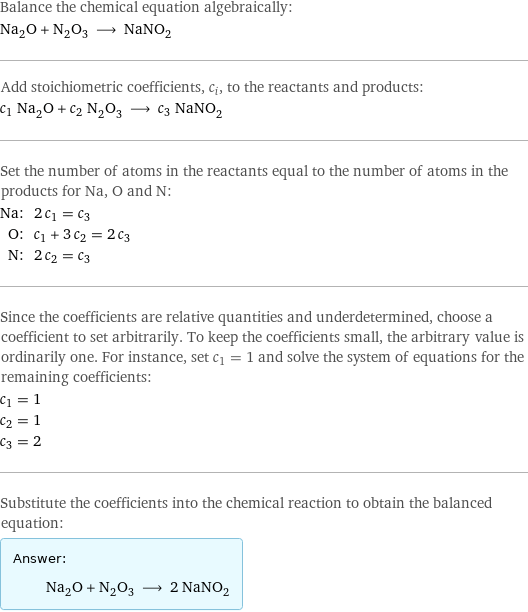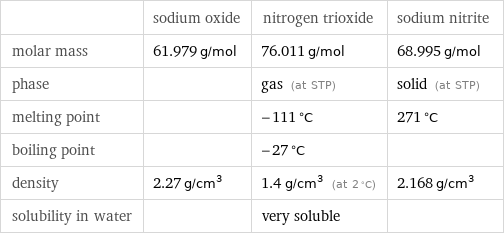Input interpretation

Na_2O sodium oxide + N_2O_3 nitrogen trioxide ⟶ NaNO_2 sodium nitrite
Balanced equation

Balance the chemical equation algebraically: Na_2O + N_2O_3 ⟶ NaNO_2 Add stoichiometric coefficients, c_i, to the reactants and products: c_1 Na_2O + c_2 N_2O_3 ⟶ c_3 NaNO_2 Set the number of atoms in the reactants equal to the number of atoms in the products for Na, O and N: Na: | 2 c_1 = c_3 O: | c_1 + 3 c_2 = 2 c_3 N: | 2 c_2 = c_3 Since the coefficients are relative quantities and underdetermined, choose a coefficient to set arbitrarily. To keep the coefficients small, the arbitrary value is ordinarily one. For instance, set c_1 = 1 and solve the system of equations for the remaining coefficients: c_1 = 1 c_2 = 1 c_3 = 2 Substitute the coefficients into the chemical reaction to obtain the balanced equation: Answer: | | Na_2O + N_2O_3 ⟶ 2 NaNO_2
Structures

+ ⟶
Names

sodium oxide + nitrogen trioxide ⟶ sodium nitrite
Equilibrium constant
![Construct the equilibrium constant, K, expression for: Na_2O + N_2O_3 ⟶ NaNO_2 Plan: • Balance the chemical equation. • Determine the stoichiometric numbers. • Assemble the activity expression for each chemical species. • Use the activity expressions to build the equilibrium constant expression. Write the balanced chemical equation: Na_2O + N_2O_3 ⟶ 2 NaNO_2 Assign stoichiometric numbers, ν_i, using the stoichiometric coefficients, c_i, from the balanced chemical equation in the following manner: ν_i = -c_i for reactants and ν_i = c_i for products: chemical species | c_i | ν_i Na_2O | 1 | -1 N_2O_3 | 1 | -1 NaNO_2 | 2 | 2 Assemble the activity expressions accounting for the state of matter and ν_i: chemical species | c_i | ν_i | activity expression Na_2O | 1 | -1 | ([Na2O])^(-1) N_2O_3 | 1 | -1 | ([N2O3])^(-1) NaNO_2 | 2 | 2 | ([NaNO2])^2 The equilibrium constant symbol in the concentration basis is: K_c Mulitply the activity expressions to arrive at the K_c expression: Answer: | | K_c = ([Na2O])^(-1) ([N2O3])^(-1) ([NaNO2])^2 = ([NaNO2])^2/([Na2O] [N2O3])](../image_source/7e786c8ef570c64512f7ef2350d4769e.png)
Construct the equilibrium constant, K, expression for: Na_2O + N_2O_3 ⟶ NaNO_2 Plan: • Balance the chemical equation. • Determine the stoichiometric numbers. • Assemble the activity expression for each chemical species. • Use the activity expressions to build the equilibrium constant expression. Write the balanced chemical equation: Na_2O + N_2O_3 ⟶ 2 NaNO_2 Assign stoichiometric numbers, ν_i, using the stoichiometric coefficients, c_i, from the balanced chemical equation in the following manner: ν_i = -c_i for reactants and ν_i = c_i for products: chemical species | c_i | ν_i Na_2O | 1 | -1 N_2O_3 | 1 | -1 NaNO_2 | 2 | 2 Assemble the activity expressions accounting for the state of matter and ν_i: chemical species | c_i | ν_i | activity expression Na_2O | 1 | -1 | ([Na2O])^(-1) N_2O_3 | 1 | -1 | ([N2O3])^(-1) NaNO_2 | 2 | 2 | ([NaNO2])^2 The equilibrium constant symbol in the concentration basis is: K_c Mulitply the activity expressions to arrive at the K_c expression: Answer: | | K_c = ([Na2O])^(-1) ([N2O3])^(-1) ([NaNO2])^2 = ([NaNO2])^2/([Na2O] [N2O3])
Rate of reaction
![Construct the rate of reaction expression for: Na_2O + N_2O_3 ⟶ NaNO_2 Plan: • Balance the chemical equation. • Determine the stoichiometric numbers. • Assemble the rate term for each chemical species. • Write the rate of reaction expression. Write the balanced chemical equation: Na_2O + N_2O_3 ⟶ 2 NaNO_2 Assign stoichiometric numbers, ν_i, using the stoichiometric coefficients, c_i, from the balanced chemical equation in the following manner: ν_i = -c_i for reactants and ν_i = c_i for products: chemical species | c_i | ν_i Na_2O | 1 | -1 N_2O_3 | 1 | -1 NaNO_2 | 2 | 2 The rate term for each chemical species, B_i, is 1/ν_i(Δ[B_i])/(Δt) where [B_i] is the amount concentration and t is time: chemical species | c_i | ν_i | rate term Na_2O | 1 | -1 | -(Δ[Na2O])/(Δt) N_2O_3 | 1 | -1 | -(Δ[N2O3])/(Δt) NaNO_2 | 2 | 2 | 1/2 (Δ[NaNO2])/(Δt) (for infinitesimal rate of change, replace Δ with d) Set the rate terms equal to each other to arrive at the rate expression: Answer: | | rate = -(Δ[Na2O])/(Δt) = -(Δ[N2O3])/(Δt) = 1/2 (Δ[NaNO2])/(Δt) (assuming constant volume and no accumulation of intermediates or side products)](../image_source/1f7a260a96b1c3594cc1a5741c6404f1.png)
Construct the rate of reaction expression for: Na_2O + N_2O_3 ⟶ NaNO_2 Plan: • Balance the chemical equation. • Determine the stoichiometric numbers. • Assemble the rate term for each chemical species. • Write the rate of reaction expression. Write the balanced chemical equation: Na_2O + N_2O_3 ⟶ 2 NaNO_2 Assign stoichiometric numbers, ν_i, using the stoichiometric coefficients, c_i, from the balanced chemical equation in the following manner: ν_i = -c_i for reactants and ν_i = c_i for products: chemical species | c_i | ν_i Na_2O | 1 | -1 N_2O_3 | 1 | -1 NaNO_2 | 2 | 2 The rate term for each chemical species, B_i, is 1/ν_i(Δ[B_i])/(Δt) where [B_i] is the amount concentration and t is time: chemical species | c_i | ν_i | rate term Na_2O | 1 | -1 | -(Δ[Na2O])/(Δt) N_2O_3 | 1 | -1 | -(Δ[N2O3])/(Δt) NaNO_2 | 2 | 2 | 1/2 (Δ[NaNO2])/(Δt) (for infinitesimal rate of change, replace Δ with d) Set the rate terms equal to each other to arrive at the rate expression: Answer: | | rate = -(Δ[Na2O])/(Δt) = -(Δ[N2O3])/(Δt) = 1/2 (Δ[NaNO2])/(Δt) (assuming constant volume and no accumulation of intermediates or side products)
Chemical names and formulas

| sodium oxide | nitrogen trioxide | sodium nitrite formula | Na_2O | N_2O_3 | NaNO_2 Hill formula | Na_2O | N_2O_3 | NNaO_2 name | sodium oxide | nitrogen trioxide | sodium nitrite IUPAC name | disodium oxygen(-2) anion | nitramide | sodium nitrite
Substance properties

| sodium oxide | nitrogen trioxide | sodium nitrite molar mass | 61.979 g/mol | 76.011 g/mol | 68.995 g/mol phase | | gas (at STP) | solid (at STP) melting point | | -111 °C | 271 °C boiling point | | -27 °C | density | 2.27 g/cm^3 | 1.4 g/cm^3 (at 2 °C) | 2.168 g/cm^3 solubility in water | | very soluble |
Units
